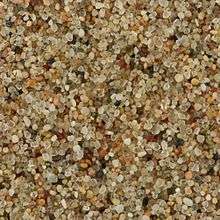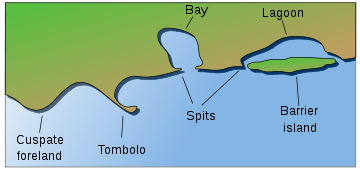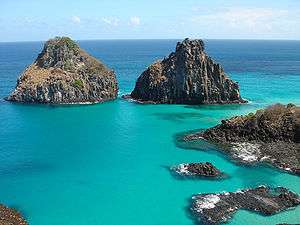Sand


Sand is a naturally occurring granular material composed of finely divided rock and mineral particles. It is defined by size, being finer than gravel and coarser than silt. Sand can also refer to a textural class of soil or soil type; i.e. a soil containing more than 85% sand-sized particles by mass.[1]
The composition of sand varies, depending on the local rock sources and conditions, but the most common constituent of sand in inland continental settings and non-tropical coastal settings is silica (silicon dioxide, or SiO2), usually in the form of quartz. The second most common type of sand is calcium carbonate, for example aragonite, which has mostly been created, over the past half billion years, by various forms of life, like coral and shellfish. For example, it is the primary form of sand apparent in areas where reefs have dominated the ecosystem for millions of years like the Caribbean.
Composition

In terms of particle size as used by geologists, sand particles range in diameter from 0.0625 mm (or 1⁄16 mm) to 2 mm. An individual particle in this range size is termed a sand grain. Sand grains are between gravel (with particles ranging from 2 mm up to 64 mm) and silt (particles smaller than 0.0625 mm down to 0.004 mm). The size specification between sand and gravel has remained constant for more than a century, but particle diameters as small as 0.02 mm were considered sand under the Albert Atterberg standard in use during the early 20th century. A 1953 engineering standard published by the American Association of State Highway and Transportation Officials set the minimum sand size at 0.074 mm. A 1938 specification of the United States Department of Agriculture was 0.05 mm.[2] Sand feels gritty when rubbed between the fingers (silt, by comparison, feels like flour).
ISO 14688 grades sands as fine, medium and coarse with ranges 0.063 mm to 0.2 mm to 0.63 mm to 2.0 mm. In the United States, sand is commonly divided into five sub-categories based on size: very fine sand ( 1⁄16 – 1⁄8 mm diameter), fine sand ( 1⁄8 mm – 1⁄4 mm), medium sand ( 1⁄4 mm – 1⁄2 mm), coarse sand ( 1⁄2 mm – 1 mm), and very coarse sand (1 mm – 2 mm). These sizes are based on the Krumbein phi scale, where size in Φ = -log2D; D being the particle size in mm. On this scale, for sand the value of Φ varies from −1 to +4, with the divisions between sub-categories at whole numbers.
.jpg)
The most common constituent of sand, in inland continental settings and non-tropical coastal settings, is silica (silicon dioxide, or SiO2), usually in the form of quartz, which, because of its chemical inertness and considerable hardness, is the most common mineral resistant to weathering.
The composition of mineral sand is highly variable, depending on the local rock sources and conditions. The bright white sands found in tropical and subtropical coastal settings are eroded limestone and may contain coral and shell fragments in addition to other organic or organically derived fragmental material, suggesting sand formation depends on living organisms, too.[3] The gypsum sand dunes of the White Sands National Monument in New Mexico are famous for their bright, white color. Arkose is a sand or sandstone with considerable feldspar content, derived from weathering and erosion of a (usually nearby) granitic rock outcrop. Some sands contain magnetite, chlorite, glauconite or gypsum. Sands rich in magnetite are dark to black in color, as are sands derived from volcanic basalts and obsidian. Chlorite-glauconite bearing sands are typically green in color, as are sands derived from basaltic (lava) with a high olivine content. Many sands, especially those found extensively in Southern Europe, have iron impurities within the quartz crystals of the sand, giving a deep yellow color. Sand deposits in some areas contain garnets and other resistant minerals, including some small gemstones.
Study


The study of individual grains can reveal much historical information as to the origin and kind of transport of the grain. Quartz sand that is recently weathered from granite or gneiss quartz crystals will be angular. It is called grus in geology or sharp sand in the building trade where it is preferred for concrete, and in gardening where it is used as a soil amendment to loosen clay soils. Sand that is transported long distances by water or wind will be rounded, with characteristic abrasion patterns on the grain surface. Desert sand is typically rounded.
People who collect sand as a hobby are known as arenophiles. Organisms that thrive in sandy environments are psammophiles.[4]
Uses

- Agriculture: Sandy soils are ideal for crops such as watermelons, peaches and peanuts, and their excellent drainage characteristics make them suitable for intensive dairy farming.
- Aquaria: Sand makes a low cost aquarium base material which some believe is better than gravel for home use. It is also a necessity for saltwater reef tanks, which emulate environments composed largely of aragonite sand broken down from coral and shellfish.
- Artificial reefs: Geotextile bagged sand can serve as the foundation for new reefs.
- Artificial islands in the Persian Gulf.
- Beach nourishment: Governments move sand to beaches where tides, storms or deliberate changes to the shoreline erode the original sand.[5]
- Brick: Manufacturing plants add sand to a mixture of clay and other materials for manufacturing bricks.
- Cob: Coarse sand makes up as much as 75% of cob.
- Concrete: Sand is often a principal component of this critical construction material.
- Glass: Sand is the principal component in common glass.
- Hydraulic fracturing: A drilling technique for natural gas, which uses rounded silica sand as a "proppant", a material to hold open cracks that are caused by the hydraulic fracturing process.
- Landscaping: Sand makes small hills and slopes (golf courses would be an example).
- Mortar: Sand is mixed with masonry cement or Portland cement and lime to be used in masonry construction.
- Paint: Mixing sand with paint produces a textured finish for walls and ceilings or non-slip floor surfaces.
- Railroads: Engine drivers and rail transit operators use sand to improve the traction of wheels on the rails.
- Recreation. Playing with sand is a favorite beach time activity. One of the most beloved uses of sand is to make sometimes intricate, sometimes simple structures known as sand castles. Such structures are well known for their impermanence. Sand is also used in children's play. Special play areas enclosing a significant area of sand, known as sandboxes, are common on many public playgrounds, and even at some single family homes.
- Roads: Sand improves traction (and thus traffic safety) in icy or snowy conditions.
- Sand animation: Performance artists draw images in sand. Makers of animated films use the same term to describe their use of sand on frontlit or backlit glass.
- Sand casting: Casters moisten or oil molding sand, also known as foundry sand and then shape it into molds into which they pour molten material. This type of sand must be able to withstand high temperatures and pressure, allow gases to escape, have a uniform, small grain size and be non-reactive with metals.
- Sand castles: Shaping sand into castles or other miniature buildings is a popular beach activity.
- Sandbags: These protect against floods and gunfire. The inexpensive bags are easy to transport when empty, and unskilled volunteers can quickly fill them with local sand in emergencies.
- Sandblasting: Graded sand serves as an abrasive in cleaning, preparing, and polishing.
- Thermal weapon: While not in widespread use anymore, sand used to be heated and poured on invading troops in the classical and medieval time periods.
- Water filtration: Media filters use sand for filtering water.
- Wuḍūʾ: the Islamic procedure for washing parts of the body.
- Zoanthid "skeletons": Animals in this order of marine benthic cnidarians related to corals and sea anemones, incorporate sand into their mesoglea for structural strength, which they need because they lack a true skeleton.
Resources and environmental concerns
Only some sands are suitable for the construction industry, for example for making concrete. Because of the growth of population and of cities and the consequent construction activity there is a huge demand for these special kinds of sand, and natural sources are running low. In 2012 French director Denis Delestrac made a documentary called "Sand Wars" about the impact of the lack of construction sand. It shows the ecological and economic effects of both legal and illegal trade in construction sand.[6][7][8]
Sand's many uses require a significant dredging industry, raising environmental concerns over fish depletion, landslides, and flooding. Countries such as China, Indonesia, Malaysia and Cambodia ban sand exports, citing these issues as a major factor.[9] It is estimated that the annual consumption of sand and gravel is 40 billion tons and sand is a $70 billion global industry.[10]
Hazards
While sand is generally non-toxic, sand-using activities such as sandblasting require precautions. Bags of silica sand used for sandblasting now carry labels warning the user to wear respiratory protection to avoid breathing the resulting fine silica dust. Safety Data sheets (SDS) for silica sand state that "excessive inhalation of crystalline silica is a serious health concern".[11]
In areas of high pore water pressure, sand and salt water can form quicksand, which is a colloid hydrogel that behaves like a liquid. Quicksand produces a considerable barrier to escape for creatures caught within, who often die from exposure (not from submersion) as a result.
See also
| Wikiquote has quotations related to: Sand |
- Beach
- Construction aggregate
- Desert sand (color)
- Dry quicksand
- Energetically modified cement (EMC)
- Heavy mineral sands ore deposits
- Oil sands
- Particle size
- Quicksand
- Revolving rivers
- Sand island
- Sand Rat
- Sandstone
- Sandstorm
- Singing sand
- White Sands National Monument
References
- ↑ Glossary of terms in soil science. (PDF). Ottawa: Agriculture Canada. 1976. p. 35. ISBN 0662015339.
- ↑ Urquhart, Leonard Church, "Civil Engineering Handbook" McGraw-Hill Book Company (1959) p. 8-2
- ↑ Seaweed also plays a role in the formation of sand. Susanscott.net (1 March 2002). Retrieved on 24 November 2011.
- ↑ "Psammophile". Merriam-Webster.com. Retrieved January 27, 2016.
- ↑ "Importing Sand, Glass May Help Restore Beaches". NPR.org. 17 July 2007.
- ↑ See Sand Wars teaser here.
- ↑ Simon Ings (26 April 2014). "The story of climate change gets star treatment". New Scientist: 28–9.
- ↑ Strände in Gefahr? Arte Future, last updated 23 April 2014
- ↑ "The hourglass effect". The Economist. 8 October 2009. Retrieved 14 October 2009.
- ↑ Beiser, Vince (26 March 2015). "The Deadly Global War for Sand". Wired (website). Retrieved 26 March 2015.
- ↑ Silica sand MSDS. Simplot (13 March 2011). Retrieved on 24 November 2011.
External links
| Look up sand in Wiktionary, the free dictionary. |
![]() Media related to Sand at Wikimedia Commons
Media related to Sand at Wikimedia Commons
- Beach Sand: What It Is, Where It Comes From and How It Gets Here Beaufort County, SC
- ISO
-
 Beach, Chandler B., ed. (1914). "Sand". The New Student's Reference Work. Chicago: F. E. Compton and Co.
Beach, Chandler B., ed. (1914). "Sand". The New Student's Reference Work. Chicago: F. E. Compton and Co.

